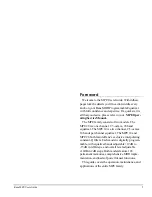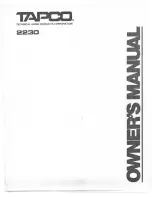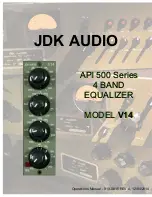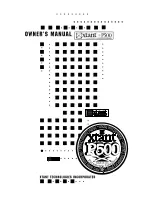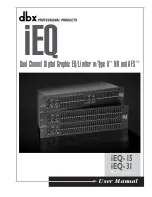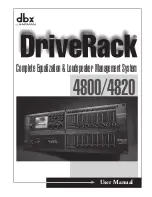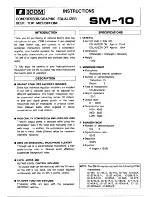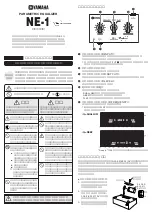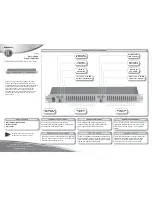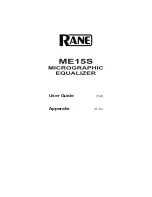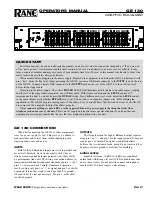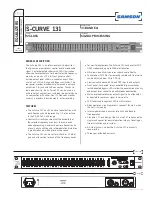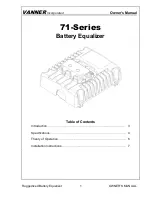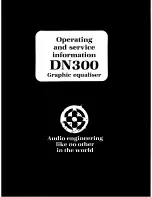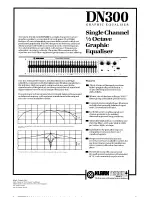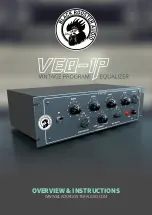
10
Rane MPE Users Guide
2. Press the UP or DOWN keys to scroll to the
desired expression controller. Any single MIDI
continuous controller number ( 0-120) may be
selected. Scrolling past number
120
120
selects
channel pressure aftertouch (displayed as
aft
aft
),
or all controllers and aftertouch (displayed as
all
all
).
A third option is the auto-detect feature (dis-
played as
det
det
). You may scroll to this option,
or access it directly by pressing the UP and
DOWN keys simultaneously. Auto-detect forces
the MPE to assign the next received MIDI con-
tinuous controller as the expression controller.
This is useful if you aren’t sure what number a
particular controller is assigned to. Once you
have the
det
det
option in the SYSTEM display,
send a message from the unknown MIDI continu-
ous controller and the MPE automatically assigns
that controller number to the expression control-
ler.
A final option is
off
off
which disables the expres-
sion function. Scrolling past
off
off
brings you full
circle to continuous controller number
0
0
.
3. Select a frequency band by pressing its key. The
current vector direction is displayed in the
EQUALIZER display. The display shows
+1
+1
for an upward (boost) vector,
-1
-1
for a downward
(cut) vector, and
0
0
for a flat vector. Remember,
bands with upward vectors boost relative to the
magnitude of the received expression controller,
bands with downward vectors cut. Bands with flat
vectors will not change.
4. Press the same band key to toggle the vector
between
+1
+1
,
-1
-1
, and
0
0
.
5. Repeat steps 1-4 until all desired vectors are
programmed.
6. Press STORE to enter the Store function, or
EXPRESS to return to Normal Operating mode.
If you chose to store your new parameters, refer
back to the Storing Working Memory section for
further instructions. Remember, if you don’t store
your changes, you will lose them next time you
recall a new Stored Memory or Factory Preset.
Curve Weighting
Sometimes the need to combine two or more
equalization curves arises. In the old days of analog
graphic equalizers, you were forced to either cascade
several units, each adjusted with one of the curves,
or tweak the sliders on one equalizer to manually
derive the sum of the curves. The MPE 14 and MPE
28 provide a curve weighting function that puts
these cumbersome methods to rest.
With the MPE curve weighting operation, you
may add two curves in the MPE together. One curve
is always in Working Memory, the other is a speci-
fied Stored Memory.
One problem can arise when adding two curves.
For example, if each of two curves has 1kHz boosted
+10dB, their sum at 1kHz 20dB. The MPE
allows a maximum of 12dB boost. Oops. Fortu-
nately, the MPE is smart. If the resultant curve is out
of range, the entire curve shifts up or down to
accommodate the curve.
An example is in order. Say we add two curves
with the following parameters:
Level
5 0
1 2 5
3 1 5
8 0 0
2 k
5 k
1 2 . 5 k
Curve 1:
0
6
7
4
- 3
0
8
2
Curve 2:
0
6
6
6
6
8
8
8
S u m :
0
1 2
1 3
1 0
3
8
1 6
1 0
As you can see in the above table, the sum of the
two curves goes out of range at 125Hz and 5kHz. At
this point we have two options. First, we can simply
truncate the out of range bands to +12dB. This
works fine, but penalizes us unnecessarily. The more
elegant option shifts the entire curve down so the out
of range bands come back in range. In the above
example, the sum is shifted down 4dB so the 5kHz
band b12dB. This results in the curve:
Level
5 0
1 2 5
3 1 5
8 0 0
2 k
5 k
1 2 . 5 k
S u m :
0
8
9
6
- 1
4
1 2
6
The curve is now entirely within range. Since we
shifted the curve down by 4 dB, the overall gain of
the unit has been reduced by 4 dB. We can take
advantage of the overall level adjustment to compen-
sate for this, resulting in the curve below:
Level
5 0
1 2 5
3 1 5
8 0 0
2 k
5 k
1 2 . 5 k
S u m :
4
8
9
6
- 1
4
1 2
6
Summary of Contents for MPE series
Page 21: ...21 Rane MPE Users Guide...

